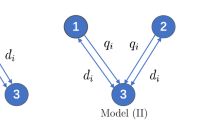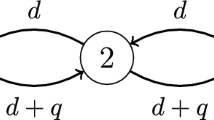Abstract
This paper is concerned with a Lotka–Volterra competition system which describes the dynamics of two aquatic species in a river with unidirectional water flow. It is assumed that two species are identical except their movement strategies distinguished by diffusion and advection rates. Assume further that the downstream end of the river is open, then at this boundary there is always a net loss of individuals incurred by water flow. Our final results suggest that when the downstream loss is small, the strategy of a combination of faster diffusion but smaller advection is always beneficial for species to win the competition; while the movement of both faster diffusion and advection can be favorable or unfavorable depending on the gap between two advection rates. Some different dynamics are illustrated when the downstream loss becomes severe.
Similar content being viewed by others
References
Anholt, B.R.: Density dependence resolves the stream drift paradox. Ecology 76, 2235–2239 (1995)
Cantrell, R.S., Cosner, C.: Spatial Ecology via Reaction-Diffusion Equations. Series in Mathematical and Computational Biology. Wiley, Chichester (2003)
Gilbarg, D., Trudinger, N.: Elliptic Partial Differential Equations of Second Order. Springer, New York (2001)
He, X., Ni, W.-M.: Global dynamics of the Lotka-Volterra competition-diffusion system: diffusion and spatial heterogeneity I. Commun. Pure. Appl. Math. 69, 981–1014 (2016)
Hershey, A.E., Pastor, J., Peterson, B.J., Kling, G.W.: Stable isotopes resolve the drift paradox for Baetis mayflies in an arctic river. Ecology 74, 2315–2325 (1993)
Hess, P., Lazer, C,A.: On an abstract competition model and applications. Nonlinear Anal. T.M.A 16, 917–940 (1991)
Hsu, S.-B., Smith, H., Waltman, P.: Competitive exclusion and coexistence for competitive systems on ordered Banach spaces. Trans. Am. Math. Soc. 348, 4083–4094 (1996)
Kowalevski, S.: Zur theorie der partiellen differentialgleichung. J. Reine Angew. Math. 80, 1–32 (1875)
Krein, M.G.: Linear operators leaving invariant a cone in a Banach space. Uspekhi Mat. Nauk (N. S.) 3, 3–95 (1948)
Lam, K.-Y., Lou, Y., Lutscher, F.: Evolution of dispersal in closed advective environments. J. Biol. Dyn. 9, 188–212 (2015)
Lou, Y., Lutscher, F.: Evolution of dispersal in open advective environments. J. Math. Biol. 69, 1319–1342 (2014)
Lou, Y., Zhou, P.: Evolution of dispersal in advective homogeneous environment: the effect of boundary conditions. J. Differ. Equat. 259, 141–171 (2015)
Lou, Y., Xiao, D.M., Zhou, P.: Qualitative analysis for a Lotka–Volterra competition system in advective homogeneous environment. Discret. Contin. Dyn. Syst. A 36, 953–969 (2016)
Lutscher, F., Lewis, M.A., McCauley, E.: Effects of heterogeneity on spread and persistence in rivers. Bull. Math. Biol. 68, 2129–2160 (2006)
Lutscher, F., McCauley, E., Lewis, M.A.: Spatial patterns and coexistence mechanisms in rivers. Theor. Popul. Biol. 71, 267–277 (2007)
Lutscher, F., Pachepsky, E., Lewis, M.A.: The effect of dispersal patterns on stream populations. SIAM Rev. 47, 749–772 (2005)
Mckenzie, H.W., Jin, Y., Jacobsen, J., Lewis, M.A.: \(R_0\) analysis of a spatiotemporal model for a stream population. SIAM J. Appl. Dyn. Syst. 11, 567–596 (2012)
Müller, K.: Investigations on the Organic Drift in North Swedish Streams, Technial Report 34, Institute of Freshwater Research, Drottningholm, Sweden (1954)
Müller, K.: The colonization cycle of freshwater insects. Oecologica 53, 202–207 (1982)
Pachepsky, E., Lutscher, F., Nisbet, R.M., Lewis, M.A.: Persistence, spread and the drift paradox. Theor. Popul. Biol. 67, 61–73 (2005)
Smith, H.: Monotone Dynamical System. An Introduction to the Theory of Competitive and Cooperative Systems. Mathematical Surveys and Monographs. American Mathematical Society, Providence (1995)
Speirs, D.C., Gurney, W.S.C.: Population persistence in rivers and estuaries. Ecology 82, 1219–1237 (2001)
Trimbee, A.M., Harris, G.P.: Use of time-series analysis to demonstrate advection rates of different variables in a small lake. J. Plankton Res. 5, 819–833 (1983)
Vasilyeva, O., Lutscher, F.: Population dynamics in rivers: analysis of steady states. Can. Appl. Math. Q. 18, 439–469 (2011)
Waters, T.F.: The drift of stream insects. Ann. Rev. Entomol. 17, 253–272 (1972)
Zhao, X.-Q.: Dynamical Systems in Population Biology. Springer, New York (2003)
Zhao, X.-Q., Zhou, P.: On a Lotka–Volterra competition model: the effects of advection and spatial variation. Calc. Var. Partial Differ. Equ. 55, 73 (2016)
Zhou, P.: On a Lotka–Volterra competition system: diffusion vs advection. Calc. Var. Partial Differ. Equ. 55, 137 (2016)
Acknowledgements
Zhou’s research is supported in part by the NSF of China (#11571363) and the AARMS Postdoctoral Fellowship, and Zhao’s research is supported in part by the NSERC of Canada.
Author information
Authors and Affiliations
Corresponding author
Appendix
Appendix
Lemma 6.1
Assume that \(d_1>d_2>0\), \(\alpha _1>\alpha _2>0\), and \(1\ge b_1\ge b_ 2>0\). Then system (1.5) has no co-existence steady state when \(\alpha _2\) is close to but bigger than \(\frac{d_2}{d_1}\alpha _1\), or \(\alpha _2\) is close to but smaller than \(\alpha _1\).
Proof
Arguing indirectly, we suppose that when \(\alpha _2\) is close to but bigger than \(\frac{d_2}{d_1}\alpha _1\), there is a co-existence steady state denoted by \((u^{\alpha _2}, v^{\alpha _2})\). By elliptic regularity [3], passing to a subsequence if necessary, we may assume that as \(\alpha _2\rightarrow (\frac{d_2}{d_1}\alpha _1)^{+}\), \((u^{\alpha _2}, v^{\alpha _2})\rightarrow (u^*, v^*)\) in \(C^2([0, L])\), where \(u^*, v^*\ge 0\) and satisfy
By Lemma 4.6, \(u^*, v^*>0\) in [0, L] cannot happen. Hence,
If \(u^*=v^*=0\), let \(\widehat{u}^{\alpha _2}=\frac{u^{\alpha _2}}{\Vert u^{\alpha _2}\Vert _{L^{\infty }}}\) and \(\widehat{v}^{\alpha _2}=\frac{v^{\alpha _2}}{\Vert v^{\alpha _2}\Vert _{L^{\infty }}}\). Then, using the elliptic regularity again, we may assume that \((\widehat{u}^{\alpha _2}, \widehat{v}^{\alpha _2})\rightarrow (\widehat{u}, \widehat{v})\) in \(C^2([0, L])\) as \(\alpha _2\rightarrow (\frac{d_2}{d_1}\alpha _1)^{+}\), where \(\widehat{u}, \widehat{v}>0\) (due to \(\Vert \widehat{u}\Vert _{L^{\infty }} =\Vert \widehat{v}\Vert _{L^{\infty }}=1\)) and satisfy
which can be rearranged as
Using the same idea as in Lemma 2.1, we can derive from (6.2) that
Moreover, multiplying the first equation in (6.3) by \(e^{-\frac{\alpha _1}{d_1}x}\widehat{v}\) and the second one by \(e^{-\frac{\alpha _1}{d_1}x}\widehat{u}\), subtracting the resulting equations, and then integrating over [0, L], one finally obtains
where the estimate in (6.4) is used. This contradiction shows that \(u^*=v^*=0\) cannot happen.
If \(u^*>0=v^*\), then \(u^*\) is the unique positive solution of
and \(\widehat{v}^{\alpha _2}=\frac{v^{\alpha _2}}{\Vert v^{\alpha _2}\Vert _{L^{\infty }}}\) defined above now converges to \(\widehat{v}\) satisfying
By Corollary 2.1, \(0<\frac{u^*_x}{u^*}<\frac{\alpha _1}{d_1}\) in (0, L), and by using the same argument as in Lemma 2.1, one can derive \(\frac{\widehat{v}_x}{\widehat{v}}<\frac{\alpha _1}{d_1}\) in (0, L) where the fact \(u^*_x>0\) was used. Next, one can use the same idea as above to deduce a contradiction, which shows that \(u^*>0=v^*\) is impossible.
Clearly, the case of \(v^*>0=u^*\) can be excluded in a similar manner. But this leads to a contradiction with (6.1). Hence, there is no co-existence steady state when \(\alpha _2\) is close to but bigger than \(\frac{d_2}{d_1}\alpha _1\).
For the situation when \(\alpha _2\) is close to but smaller than \(\alpha _1\), we can prove the result in the same spirit as above with some obvious modifications. \(\square \)
Lemma 6.2
Given \(d_1>d_2>0\), \(\alpha _1>0\), and \(1\ge b_1\ge b_ 2>0\). Assume that both \((\widetilde{u}, 0)\) and \((0, \widetilde{v})\) exist for any \(\alpha _2\in (0, \alpha _1)\). Then there must exist \(\alpha _2\in [\mu _1, \mu _2]\) such that system (1.5) admits a co-existence steady state.
Proof
We first explain how to guarantee the above assumption. Given \(d_1>d_2>0\), \(\alpha _1>0\) and \(1\ge b_1\ge b_ 2>0\). For any \(\alpha _2\in (0, \alpha _1)\), since \(L_{1, 2}^*\) are increasing functions in \(\alpha \) [12, Lemmas 2.1, 2.2], we can choose suitably large r and L (not depending on \(\alpha _2\)) to satisfy the sufficient and necessary condition given in Proposition 2.1, and thus both \((\widetilde{u}, 0)\) and \((0, \widetilde{v})\) exist for any \(\alpha _2\in (0, \alpha _1)\).
Next, we use an argument developed in [27] to finish this proof. Fix \(\nu _1\in (0, \mu _1)\) and \(\nu _2\in (\mu _2, \alpha _1)\), and define
Let \(X^+\) be the set of all non-negative continuous functions from \(\mathbb {R}\) to \(\mathbb {R}\) and define \(K:=X^+\times (-X^+)\) as the usual cone for the study of competitive systems with nonempty interior given by \(\text {Int} K=\text {Int} X^+\times (-\text {Int} X^+)\). Let \(\le _{K}, <_{K}, \ll _{K}\) denote the partial order relations generated by K (see, e.g., definitions in [7]). Moreover, for any \(\alpha _2\in \Gamma \), we denote by \(T_{t}^{\alpha _2}\) the continuous semi-flow generated by system (1.5).
Suppose to the contrary that system (1.5) has no co-existence steady state for any \(\alpha _2\in \Gamma \). Then in view of [7, Theorem B], the dynamics of system (1.5) is clear if initial conditions are confined in
where we use \(\widetilde{v}_{\alpha _2}\) instead of \(\widetilde{v}\) to emphasize the dependence on \(\alpha _2\). More specifically, if we define
and
then
We claim that both \(\Gamma _1\) and \(\Gamma _2\) are open. In fact, for any given \(\alpha _2^0\in \Gamma _1\), we choose a point \((u_0^1, v_0^1)\) in \(\Sigma _{\alpha _2^0}\) satisfying \((0, \widetilde{v}_{\alpha _2^0})\ll _{K}(u_0^1, v_0^1)\ll _{K}(\widetilde{u}, 0)\). By the continuous dependence of \(\widetilde{v}_{\alpha _2}\) on \(\alpha _2\), there exists \(\delta _1>0\) small such that for all \(|\alpha _2-\alpha _2^0|<\delta _1\),
Since \(T_{t}^{\alpha _2^0}(u_0^1, v_0^1)\rightarrow (\widetilde{u}, 0)\gg _K (u_0^1, v_0^1)\) as \(t\rightarrow \infty \), there exists a large time \(t_0>0\) such that
Using the continuous dependence of \(T_{t_0}^{\alpha _2}(u_0^1, v_0^1)\) on \(\alpha _2\), one finds that there exists \(0<\delta _2<\delta _1\) such that for all \(|\alpha _2-\alpha _2^0|<\delta _2\),
which implies that \((\alpha _2^0-\delta _2, \alpha _2^0+\delta _2)\cap \Gamma _2=\emptyset \), and hence, \((\alpha _2^0-\delta _2, \alpha _2^0+\delta _2)\subset \Gamma _1\). Similarly, one can verify that \(\Gamma _2\) is also open. This establishes the above claim.
Clearly, both \(\Gamma _1\) and \(\Gamma _2\) are non-empty since \((\nu _1, \mu _1)\subset \Gamma _1\) and \((\mu _2, \nu _2)\subset \Gamma _2\). Combining this fact, the above claim, and the decomposition in (6.5) together, we obtain a contradiction. Hence, for some \(\alpha _2\in \Gamma \), system (1.5) has a co-existence steady state. Actually, such \(\alpha _2\) must be in \([\mu _1, \mu _2]\) in view of the global dynamics described in statements (1) and (2) in Theorem 1.1. \(\square \)
Rights and permissions
About this article
Cite this article
Zhou, P., Zhao, XQ. Global Dynamics of a Two Species Competition Model in Open Stream Environments. J Dyn Diff Equat 30, 613–636 (2018). https://doi.org/10.1007/s10884-016-9562-2
Received:
Revised:
Published:
Issue Date:
DOI: https://doi.org/10.1007/s10884-016-9562-2




